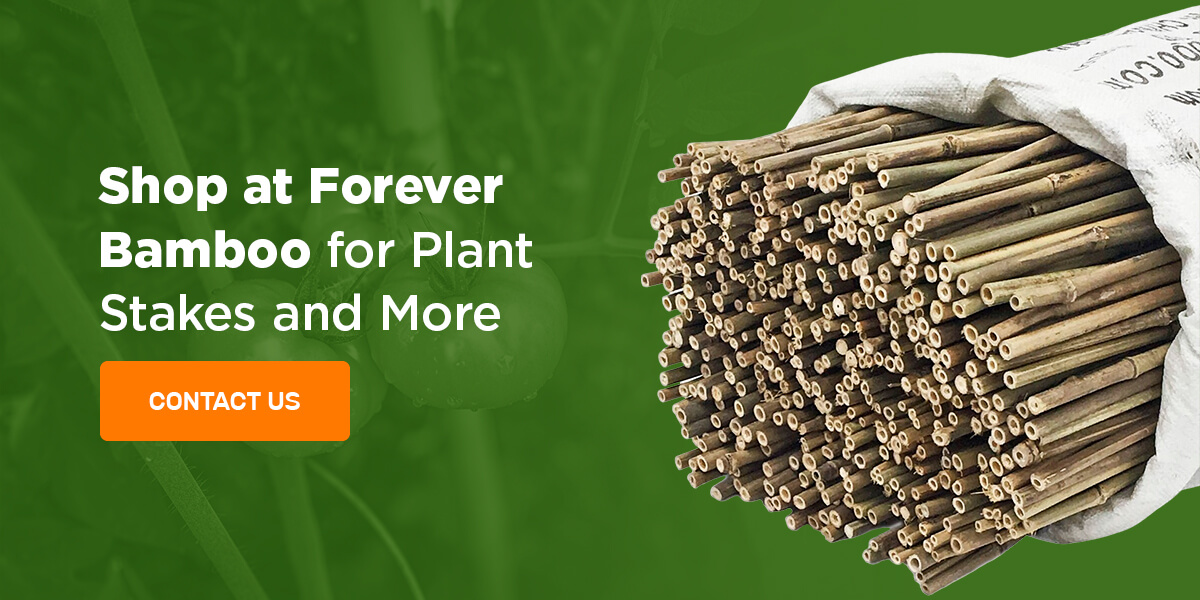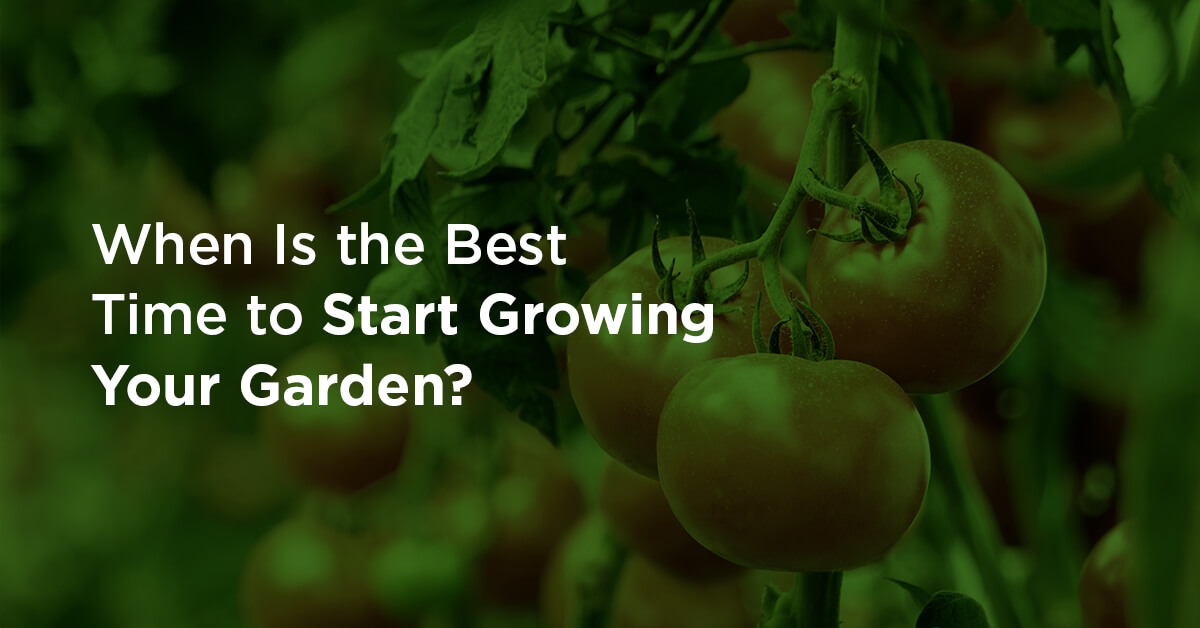
Gardening is a popular hobby for plenty of reasons. It offers an ideal source of low-impact exercise while getting you the fresh air and sunshine you need. In addition, gardening provides you with tasty produce to help you make healthy meals. Gardening can also serve as landscaping, freshening up your yard with beautiful, colorful scenery.
Whether you prefer to plant flowers, vegetables, fruits or trees, gardening is a fun and rewarding activity.
If you’re a beginner and have questions about how to grow a garden, below are some of the best plants to grow during each season — and general tips for promoting a healthy garden.
Jump to Sections:
- Best Crops to Grow and When to Plant Them
- Best Crops to Grow in Spring
- Best Crops to Grow in Summer
- Best Crops to Grow in Fall
- Best Crops to Grow in Winter
- How to Support Garden Growth
- How to Support Plant Growth With Bamboo Plant Stakes
- Shop at Forever Bamboo for Plant Stakes and More
Best Crops to Grow and When to Plant Them
Each season is an ideal gardening time for various plants. Even the winter can serve as a germination period for hardy, cool-weather plants. With gardening, timing is everything — choosing the right season to add each plant will have a major impact on your garden’s health. You can keep gardening all year long if you choose the right crops at the right times. While some plants prefer cool, dry soil, others prefer warm, damp soil or something in between. Ultimately, the best time to start growing a garden depends on what you plan to grow.
Here are some popular seasonal plants you might want to include in your garden, including a variety of vegetables, fruits and decorative flowers.
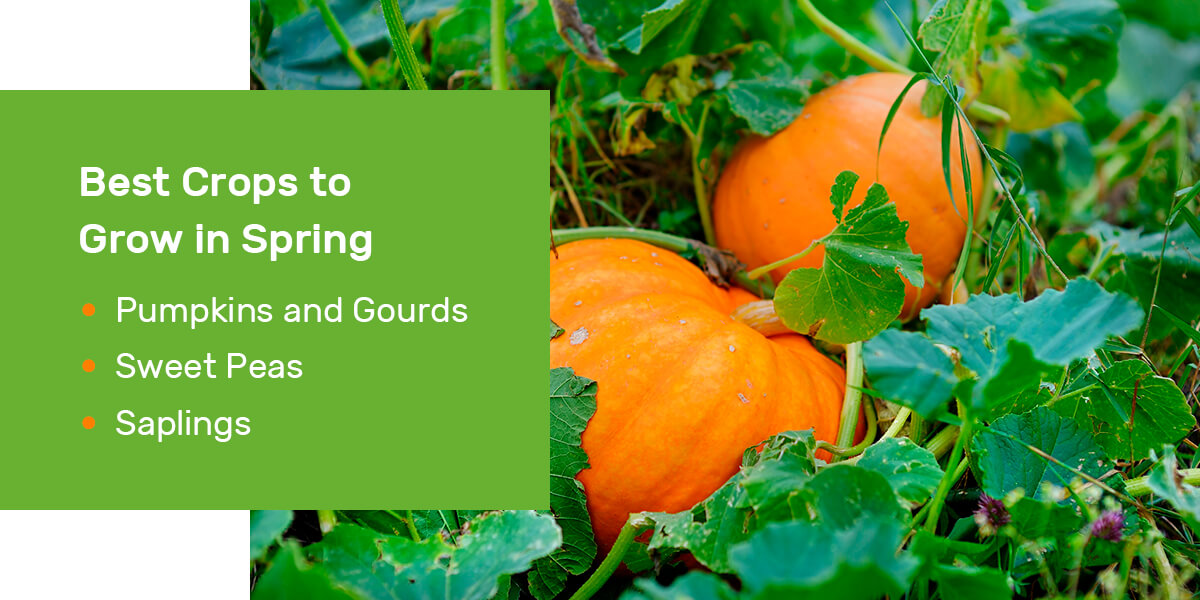
Best Crops to Grow in Spring
Springtime is famous for its gardening potential. The warmer weather and rainfall create a friendlier environment for a wide range of plants, including:
1. Pumpkins and Gourds
Both pumpkins and gourds are fun to include in your garden, especially if you give them enough time to grow big by the Halloween season. They make perfect fall-themed decorations. Always plant pumpkins and gourds after any chance of frost has passed, which is usually in the late spring. Remember, pumpkins need a lot of space, so you’ll need to have a large enough garden for successful pumpkin growth.
2. Sweet Peas
Sweet peas are a lovely addition to any garden, producing beautiful, ruffled flowers and a gentle perfume. While they don’t produce edible pods, you can save the pods for future growing purposes. Plant them as soon as the soil is workable in the late winter or early spring.
3. Saplings
The best season for gardening tree saplings is middle to late spring. Young trees prefer thawed but not dry soil, so both winter and summer can create unfavorable conditions. Spring provides the soft, damp soil saplings need to start growing.
When you plant a sapling, make sure the uppermost roots have a light soil covering. Planting the roots too deep might expose the tree to soil diseases, but planting the roots too shallow can cause them to dry out or may result in the tree falling over.
Best Crops to Grow in Summer
Summer is a great time for growing crops, especially tasty vegetables. Plenty of different plants love the warmth, sunlight and heavy rainfall that’s characteristic of summer. Here are some plants to garden throughout the summer:
1. Cucumbers
Cucumbers thrive in hot, wet seasons. Since they’re unable to survive frost, it’s important to wait for consistently warm weather before planting them. They prefer full sun and need plenty of room for their 3- to 4-foot long roots and 6- to 8-foot long vines. Be sure to water your cucumbers often in the absence of regular rainfall.
2. Tomatoes
The perfect plant for warmth and sunlight is a tomato. Keep in mind, tomatoes always need vertical support — they’re unable to stay upright on their own. When planting, it’s a good idea to bury a good portion of the stem so it’ll grow strong, sturdy roots, well-prepared to find water during a dry period. Water your tomatoes often.
3. Bell Peppers
Bell peppers are another warm-season vegetable. Though they’re most sensitive to the cold, they also blossom less when average temperatures are particularly hot. It’s a good idea to grow bell peppers in early summer before temperatures get too high. Use clippers or pruners when harvesting your peppers to avoid damaging the stems.
4. Pole Beans
Another tasty summertime treat is a pole bean. Pole beans are easy to cook and make any meal a little greener. They won’t survive frost, so it’s best to wait for summer to plant them. You’ll need to harvest the full, green pods every few days to encourage new flowers and longer vines.
5. Dahlias
Dahlias yield large, bright and intricate flowers perfect for livening up your garden. You can start them indoors while the weather warms up. As a general rule, dahlias should be in the ground about the same time as tomatoes. Make sure they have plenty of sunlight and nutritious soil.
Best Crops to Grow in Fall
Fall might seem like the wrong time to be putting plants in the ground, but it’s actually the best planting season for many spring bloomers. You’ll have a bright and colorful garden blossoming before you know it when you plant these in the fall:
1. Peonies
Peonies offer beautiful blooms and full foliage — they can make any garden more beautiful. They should be settled into place before the ground freezes. Try to get them into the soil by September or October for the best results, and make sure they have full sun.
2. Lilies
Lilies — with their unique shapes, bright colors and butterfly-attracting capabilities — do well when planted in the fall. Different types of lilies grow to different heights. If you want a tall flower, choose oriental lilies, which grow about 4 feet high. Shorter varieties include Asiatic lilies, which grow about 2 or 3 feet high. Lilies will brighten things up after the winter, as they tend to bloom in late spring or early summer.
3. Blackberries
If you want to grow your own delicious, juicy blackberries, plant them in the late fall. If you live in an especially cold area, wait until early spring. One of the nice things about blackberries is that they’re self-fertile, so just one plant will yield fruit.
Keep in mind, blackberries need full sun and nutritious soil. They also need a bit of space — if you want a collection of blackberry plants, line them up at least 5 feet apart in rows 8 feet apart.
4. Roses
Roses are a versatile and hardy flower you can plant at different points throughout the year. If you plant them in the fall, give them at least a month to extend their roots into the soil before the first frost in your region. They’ll go dormant for the winter and bloom in the spring.
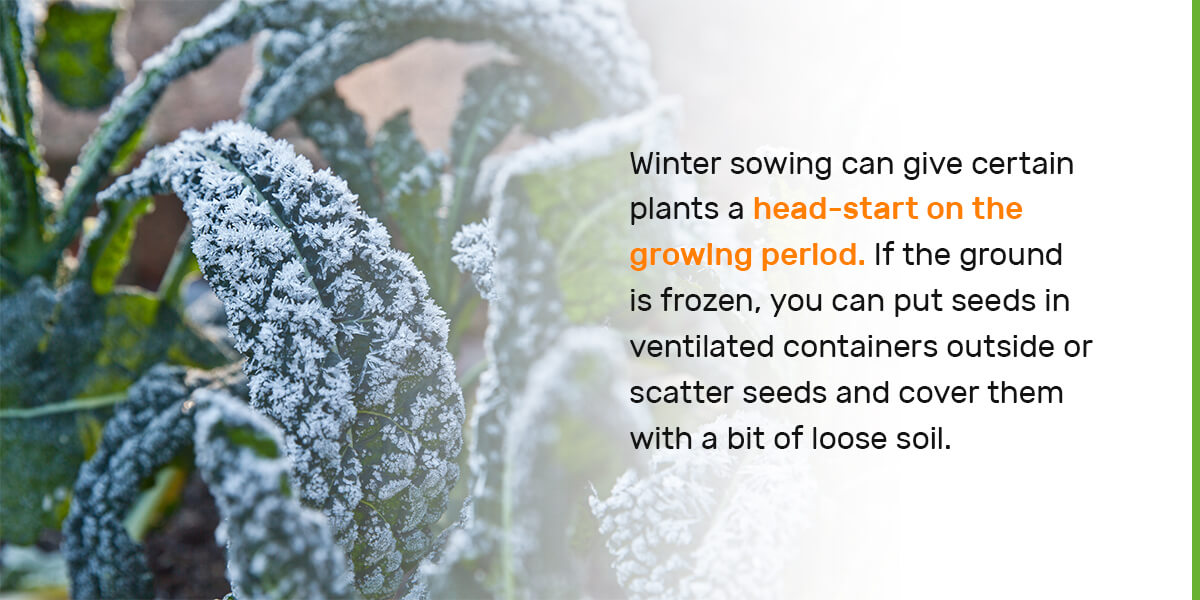
Best Crops to Grow in Winter
You don’t need to pause your gardening when the weather turns cold. Winter sowing can give certain plants a head-start on the growing period. If the ground is frozen, you can put seeds in ventilated containers outside or scatter seeds and cover them with a bit of loose soil. Some of the seeds will germinate this way.
For winter gardening, choose hardy plants such as the following:
1. Butterfly Weed
Butterfly weed yields bright, warm-colored flowers. As the name suggests, the blossoms attract butterflies, other insects and hummingbirds. They’re ideal winter plants, as they prefer dry soil and can tolerate droughts. Note, they may need a couple of years to get started before you’ll start seeing blooms.
2. Kale
Kale is a cold-season vegetable you can plant in the winter — it’s much more tolerant of cold than of heat. In fact, kale is one of the vegetables that will taste sweeter after enduring a frost. Its nutrient-rich leaves will make a great cooking ingredient in the spring.
How to Support Garden Growth
Having a green thumb is all about providing support for your garden and promoting plant growth. Here are some important things to keep in mind when gardening to encourage healthy, blooming plants.
1. Choose the Right Spot for Each Plant
One of the most important aspects of gardening is to choose the right spot for each plant. Make sure every plant has the amount of sunlight it needs to thrive — putting a full sun plant in the shade won’t do it any good.
2. Enrich Your Soil
Check that your soil is nutrient-rich. Mix in some compost, such as leaves or aged bark. You can also purchase soil nutrient blends if needed. The best soil will hold together when squeezed but break apart when disturbed. Soil with these characteristics indicates the presence of microorganisms, which will feed your plants’ roots.
3. Water With Care
Even gardening novices know that watering too much or too little can damage plants. Be sure to factor rainfall into your watering schedule. You might also consider installing drip lines through your garden, which give roots plenty of time to absorb the moisture. Remember, wetting plant leaves or foliage too much can lead to disease.
How to Support Plant Growth With Bamboo Plant Stakes
Another way to boost your garden’s success is to support plants with bamboo plant stakes. Many common garden plants benefit from having something to lean on. Sturdy plant stakes can help keep your plants healthy and strong.
Why Use Plant Stakes?
Many gardeners choose to use plant stakes for certain plants. Using stakes:
- Keeps delicate stems from snapping.
- Keeps top-heavy plants from flopping or falling over.
- Encourages healthy, vertical growth.
- Helps young plants withstand harsh weather conditions.
Why Use Bamboo Plant Stakes?
While some plant stakes are made from flimsy material, bamboo is extremely strong. Its strength makes it long-lasting and versatile, useful for a wide range of different plant types. As one of the fastest-growing plants in the world, bamboo is also a sustainable choice.
What Plants Need Stakes?
Many different plants rely on support when growing in the wild, using trees or other tall, sturdy structures surrounding them. Any of the following plant types will need stakes for the best growth:
- Plants with large, top-heavy blooms like peonies.
- Plants with heavy vegetables, like pumpkins or tomatoes.
- Plants that rely on support, like saplings.
- Vine-like plants, such as cucumbers.
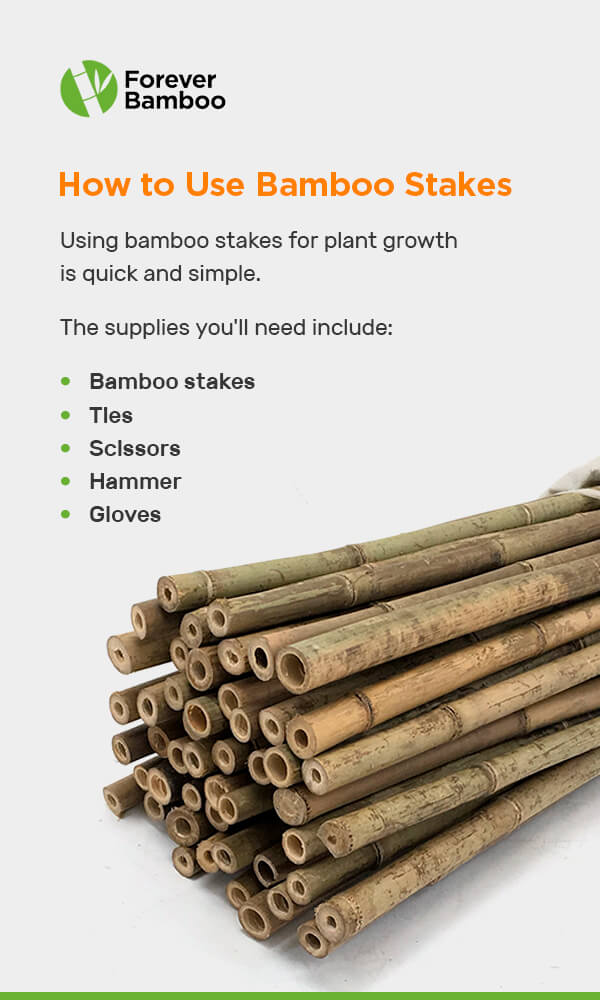
How to Use Bamboo Stakes
Using bamboo stakes for plant growth is quick and simple. The supplies you’ll need include:
- Bamboo stakes: You’ll need one or more bamboo stakes, depending on the size and nature of the plant. Vines may need only one stake, while tomatoes need at least two small stakes.
- Ties: The type of ties you use will depend on the plant. Use soft, stocking-like ties for plants that need wiggle room. Alternatively, you’ll want to use a chain tie for plants that grow quickly, which unlock so you can adjust them at any time. Roses require chain ties.
- Scissors: With scissors, you’ll cut your ties to the length you need.
- Hammer: A hammer will allow you to secure your stakes into the ground.
- Gloves: Wear gardening gloves to protect your hands.
Once you’ve gathered all of your supplies, staking your plants will only take a few minutes. Follow these steps for staking your plants:
- If your plant is partially grown already, look at which way it’s leaning.
- Put your stake in a position to straighten the plant and encourage upright growth.
- Be sure to put in stakes immediately after planting the crop to avoid damaging the roots.
- Hammer in each stake until it’s secure. You might want to pull on it to make sure it stays in place.
- Double strap the tie around your plant and stake — or around the plant and each stake if you’re using more than one.
- Cut the tie and double knot it into place.
- If the stem is long, use ties in two or more places.
Get Bamboo Stakes in Bulk
You can get the stakes you’ll need for your entire garden at once when you buy bamboo stakes in bulk bundles of 50 pieces or more. You can choose from stakes with various diameters, from one inch to 3/8 inches. Use thicker bamboo pieces for heavier plants, such as tree saplings.
Shop at Forever Bamboo for Plant Stakes and More
Planting the right crops during the right seasons can help you make your garden thrive. Whether you’re gardening for a colorful, butterfly-attracting yard or some fresh produce to your diet, following best practices will help you find the most success. Be sure to plant each crop during the best time of year. You should also be mindful about placement, soil nutrients, water and growing supports.
You can promote growth by supporting your plants with bamboo stakes. Bamboo is durable, strong, sturdy and sustainable. When you buy bamboo stakes in bundles, you’ll be able to use them throughout your entire garden — lots of different plants benefit from a little extra support.
Choose Forever Bamboo for your bamboo plant stakes. At Forever Bamboo, we offer everything you need for your outdoor spaces, including bamboo fencing and furniture, roof thatch, surfacing and tropical decor. Shop Forever Bamboo products and create the outdoor space of your dreams!

